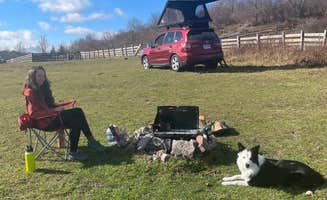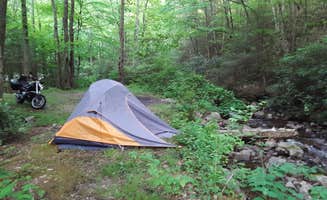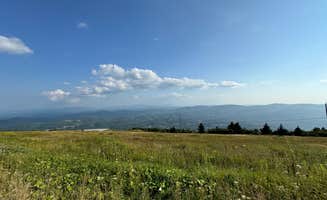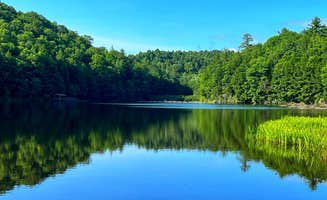Dispersed camping near Roaring Gap, North Carolina offers primitive sites requiring self-sufficiency in water, waste management, and navigation. The terrain varies from 2,500 to 5,500 feet elevation with temperature fluctuations of 15-20 degrees between valleys and peaks. Most sites lack amenities but provide seclusion along forest service roads that require careful navigation during wet seasons when mud and erosion create challenging conditions.
What to do
Hike the Appalachian Trail: Access points near Scales Trailhead Basecamp connect to miles of scenic trails. "We've been going to Scales for several years now, & it's one of the few places we keep revisiting! It's right on the AT, so there are lots of through hikers that you'll see stop in for a night. That also means that there's lots of great hiking options," notes Jay N.
Mountain biking: The Virginia Creeper Trail offers downhill routes suitable for beginners and families. A camper at Mount Rogers National Recreation Area mentioned, "Within 3 miles of these spots along the creek, you will find the famous and gorgeous Virginia Creeper Trail, the Whitetop Laurel Creek, and the Appalachian Trail. So bring your bikes, fishing poles, kayaks, and hiking boots for a full week of adventure."
Wildlife viewing: Wild ponies roam the highlands throughout spring and summer. "My partner and I took our dog on a quick impromptu weekend trip... The salt lick for the ponies wasn't far so if you're looking for a weekend getaway with great sites, a little adventure and a whole lot of beauty this campground is for you," writes Mateo M.
What campers like
Creekside camping: Many sites sit alongside running water providing both ambiance and practical benefits. A visitor to Washington & Jefferson National Forest Dispersed Sites shared, "Overall this was a great little spot right off the road. The sound of the creek was lovely all night." Alexandra T. added, "Loved this spot - we got lucky and parked right next to a swimming hole, had a gorgeous swim and enjoyed our time."
Morning views: Higher elevation sites reward early risers. "Good morning! Rolled up late 1am thru the forest to sleep... 6am woke up to watch the sunrise and there rolled the mountains," reports a camper at Whitetop. Another noted, "The next morning was still foggy. As we're getting ready to head out for the day, all of a sudden the sun came out and we were ABOVE THE CLOUDS. It was absolutely stunning."
Community connections: Through-hikers and seasonal regulars create unique social opportunities. At Scales Trailhead Basecamp, "Some of the other campers introduced themselves and were extremely friendly and helpful. Some had been camping there for 40yrs," writes Mateo M.
What you should know
Road conditions: Many sites require appropriate vehicles. "The road in is...rocky. High clearance 4wd needed. Not ADV friendly, unless you're very adventurous," warns Jon M. about Scales Trailhead. Similar conditions exist at Whitetop where Emerald M. reports, "The road to this site is WILD, but doable! I'll leave photos of the worst spots to help you decide whether or not you should drive up to the top."
Communication limitations: Cell service remains minimal to non-existent. "There is absolutely no cell service at this camp, you have to go into town or hike a local mountain to get service up high," explains Shari G. Matthew C. confirms: "Very little Verizon and AT&T signal."
Environmental awareness: Site selection impacts comfort dramatically. A camper at Mount Rogers National Recreation Area found "It was totally empty in March - we didn't see a single soul. Got a beautiful campsite right on the creek." However, trash management continues to be an ongoing concern, with several sites requiring cleanup upon arrival.
Tips for camping with families
Choose roadside sites: Families may prefer more accessible locations. At Washington & Jefferson National Forest, a reviewer noted, "Right next to the road, so first time campers would feel safe." This provides quick evacuation options if needed while maintaining access to recreation.
Pack layers: Temperature variations of 20-30 degrees within 24 hours are common. One camper at Whitetop shared, "The wind is killer. We ended up moving our tent to the other side of the car park at the top. There's a nice little piney forest which provided a little shelter from the wind."
Stream crossings: Water levels fluctuate rapidly with rainfall. Many forest service roads have unbridged stream crossings that can become impassable after storms. Be prepared to adjust travel routes or timing based on conditions.
Tips from RVers
Size restrictions: Most dispersed sites accommodate smaller rigs only. "It was a pull-thru so it would be convenient for trailers, too," notes Charles about a Mount Rogers site, though most areas have limited turning radius and overhead clearance.
Supply planning: Services remain distant from camping areas. The closest resupply point for most sites is Damascus, Virginia, approximately 12 miles from camping areas with limited hours at local businesses.
Site arrival timing: Arriving before dark significantly improves site selection. "It was dark when we pulled up and difficult to see the campsites if they were not occupied already," reports Emerald M. about finding suitable spots at Whitetop.





